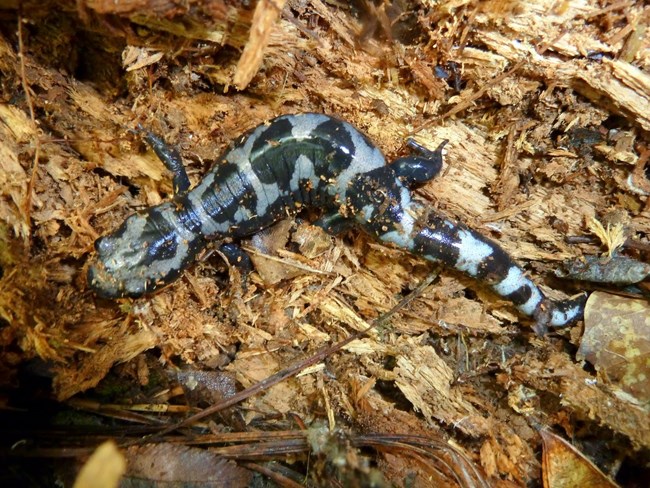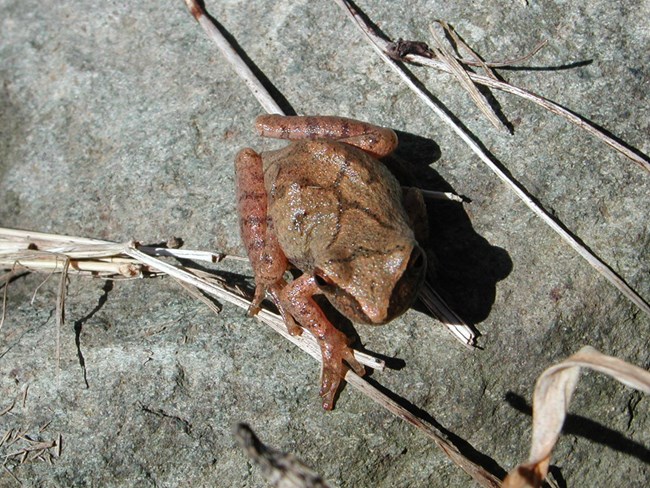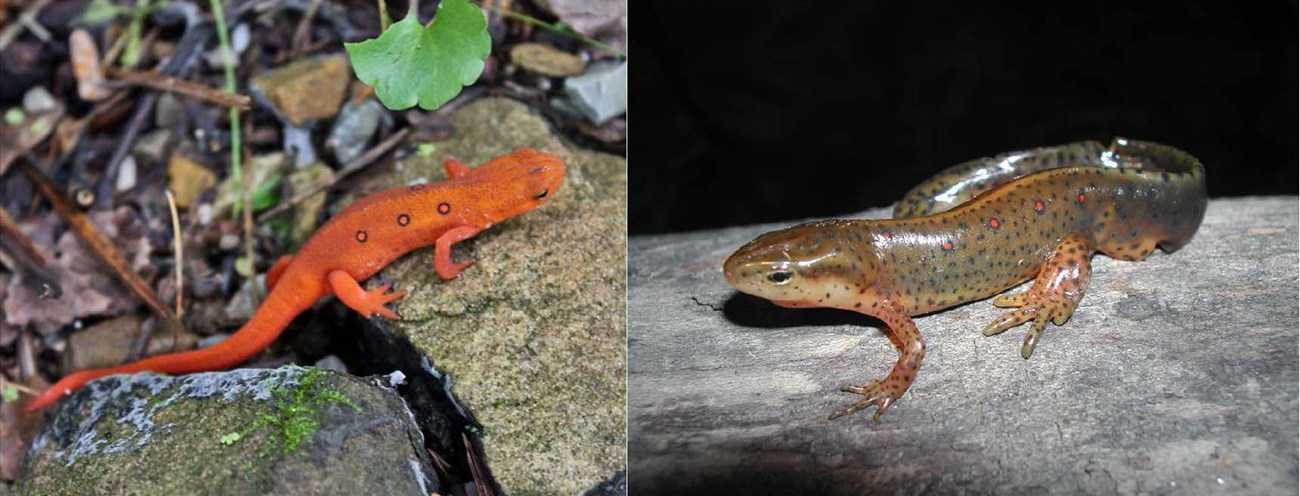Last updated: April 29, 2022
Article
Autumn Amphibians

NPS
by Charlie Shafer, Biological Science Technician with the U.S. Geological Survey and amphibian monitoring collaborator with National Capital Region Network Inventory & Monitoring (NCRN I&M)
Most amphibians lay their eggs in spring. But as hot summer temperatures subside and cooler fall weather moves into the region, a few amphibian species get a headstart on this timeline and begin breeding in the fall months.
Marbled Salamanders
One such species is the marbled salamander (Ambystoma opacum) and it’s the only amphibian species in the National Capital Region (NCR) to breed primarily in the fall. These short, stout salamanders feature a black body with white bands across their backs. Marbled salamanders emerge from the soil to lay eggs in the fall after the wetlands have drawn down from hot summer temperatures and reduced rainfall. Even though the larvae that hatch will be aquatic and require gills to breathe, the eggs are actually laid outside of the water on the slope of the wetland basin. The eggs then develop outside the water, but larvae don’t emerge until the fall and winter rains refill the wetlands and fully submerge the eggs.
In the NCR, it is not uncommon to see newly hatched marbled salamander larvae in mid-to-late November. However, they are not documented until March or April, when NCRN I&M amphibian monitoring restarts in the parks.

NPS
Spring Peepers
Another species that is active in the fall is the spring peeper (Pseudacris crucifer). This small, tan frog features an X-shaped pattern on its back and can be quite elusive from observation visually, but it’s high-pitch call is hard to miss. The early emergence of spring peepers in the spring (hence the name) would not be possible without some important biological preparations that take place the previous fall and winter. By fall, spring peepers are quickly producing eggs and sperm for the breeding season that takes place in the following year. Their classic spring “peep” call can be heard occasionally on warm nights in October or November. Though they are nearly at breeding stage by the end of fall, the oncoming cold temperatures force them to wait until spring to begin breeding.
Peepers possess an important substance that helps them survive the coldest winter temperatures and allows them to emerge early the following spring. When temperatures begin to dip, their bodies produce a kind of “antifreeze” that helps protect them from freezing and increases their chances of survival over winter. This interesting ability allows them to prepare for breeding the previous fall, and have a head start the following spring before other species have emerged.
Red-Spotted Newts

NPS
Autumn is when the bright red-orange juvenile stage of the red-spotted newt (Notophthalmus viridescens), called a red eft, is typically observed as it moves across the landscape to prepare for winter. The red-spotted newt has one of the most unique life histories out of all the amphibians in the NCR. The eggs hatch as aquatic larvae, and once developed, the larva metamorphose into land-based red efts. After about four years, the efts return to the water and transform into the adult newt form. The adults remain in this aquatic form for the rest of their lives, and they continue to breed each year. Adult newts have yellow undersides and olive-green backs with red-orange spots, while the red efts are a bright red-orange color all over their bodies. These distinct colors serve as a warning to any would-be predators, as newts can secrete toxins from their skin when in distress.
Red-spotted newt populations are relatively stable (neither expanding nor contracting) which makes it one of the more important species in the I&M amphibian monitoring program. Studies have shown that red-spotted newts are particularly susceptible to an emerging chytrid fungus named Batrachochytrium salamandrivorans (Bsal). Bsal is a pathogen that has not yet been detected within the U.S., but monitoring the occupancy trends of red-spotted newts will give us insight into the potential introduction of this pathogen in the future.
Tags
- antietam national battlefield
- catoctin mountain park
- chesapeake & ohio canal national historical park
- george washington memorial parkway
- harpers ferry national historical park
- manassas national battlefield park
- monocacy national battlefield
- national capital parks-east
- prince william forest park
- rock creek park
- wolf trap national park for the performing arts
- amphibian
- amphibian monitoring
- newts
- ncrn
- salamanders
- frogs
- spring peeper
- red-spotted newt
- marbled salamander
- ambystoma opacum
- notophthalmus viridescens
- pseudacris crucifer
- i&m
- natural resource quarterly
- fall 2021
- bsal
- chytrid
- nature
